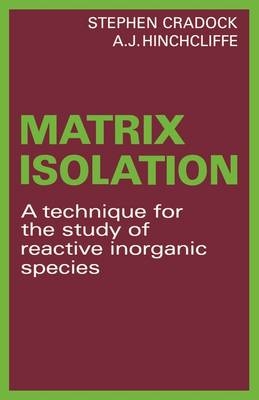
Matrix Isolation
A Technique for the Study of Reactive Inorganic Species
Seiten
2011
Cambridge University Press (Verlag)
978-0-521-27545-3 (ISBN)
Cambridge University Press (Verlag)
978-0-521-27545-3 (ISBN)
In simple terms matrix isolation involves trapping a reactive species in a frozen cage, or matrix, of an inert medium such as a rare gas. This 1975 book shows how and why the technique developed and describes the necessary apparatus, showing how each of the technological problems may be overcome.
Many chemical species are too reactive under normal conditions to allow normal spectroscopic investigation. The technique of matrix isolation was developed to exploit the stabilisation that arises when the reactive species is physically trapped, restricting its freedom of movement and access to possible reaction partners. The use of cryogenic conditions to achieve the physical trapping brought valuable consequences in reducing the energy available to the species, meaning they can be studies using a variety of spectroscopic techniques. In simple terms the technique involves trapping a reactive species in a frozen cage, or matrix, of an inert medium such as a rare gas or in other situations nitrogen or carbon monoxide. This 1975 book shows how and why the technique developed and describes the necessary apparatus in some detail, showing how each of the technological problems may be overcome.
Many chemical species are too reactive under normal conditions to allow normal spectroscopic investigation. The technique of matrix isolation was developed to exploit the stabilisation that arises when the reactive species is physically trapped, restricting its freedom of movement and access to possible reaction partners. The use of cryogenic conditions to achieve the physical trapping brought valuable consequences in reducing the energy available to the species, meaning they can be studies using a variety of spectroscopic techniques. In simple terms the technique involves trapping a reactive species in a frozen cage, or matrix, of an inert medium such as a rare gas or in other situations nitrogen or carbon monoxide. This 1975 book shows how and why the technique developed and describes the necessary apparatus in some detail, showing how each of the technological problems may be overcome.
Preface; 1. Introduction; 2. Matrix models and their properties; 3. Cryogenic, vacuum and oven technology; 4. Production of matrices containing reactive species; 5. Application of spectroscopy to matrix-isolated species; 6. Effects of the matrix on spectroscopic properties; 7. Fragment molecules studied in matrices; 8. Unusual metal compounds; 9. Conclusions and outlook; Bibliography; Index.
| Erscheint lt. Verlag | 22.9.2011 |
|---|---|
| Zusatzinfo | Worked examples or Exercises |
| Verlagsort | Cambridge |
| Sprache | englisch |
| Maße | 140 x 216 mm |
| Gewicht | 200 g |
| Themenwelt | Naturwissenschaften ► Chemie ► Anorganische Chemie |
| ISBN-10 | 0-521-27545-8 / 0521275458 |
| ISBN-13 | 978-0-521-27545-3 / 9780521275453 |
| Zustand | Neuware |
| Haben Sie eine Frage zum Produkt? |
Mehr entdecken
aus dem Bereich
aus dem Bereich
Buch | Hardcover (2024)
Springer Spektrum (Verlag)
CHF 89,95


